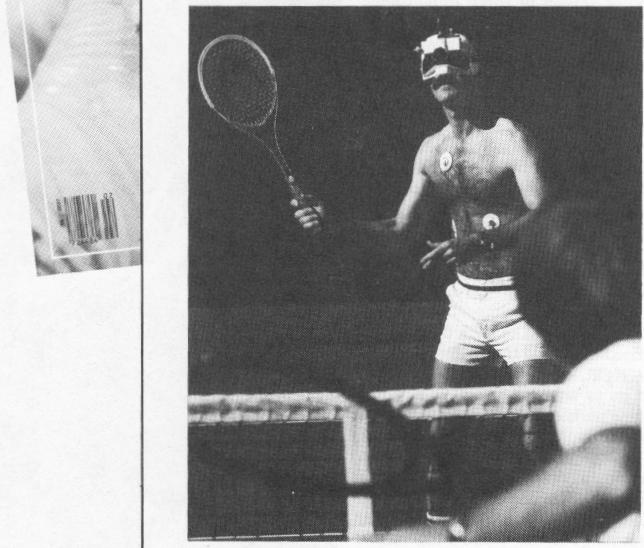| Index | Next |
BAS OVER
ANIMAL
RESEARCH
LE
dET M1
A LABORATORY
FOR JOCKS
Tennis professor Vic Braden wires athletes and their
playing fields to improve performance
by BRUCE SCHECHTER
ALL PHOTOGRAPHS BY DAVID STRICK
Tennis star Don Budge had a secret, and Vic Braden wanted to know what it was. Though Budge in the 1940s routinely played in broad daylight before large crowds, no one had ever understood how he was able to put so much power into his backhand shots. Braden, though still a youngster at the time, had within him the seeds of a tennis researcher. He hitchhiked from his home in Monroe, Michigan, to Detroit, where Budge was to play Bobby Riggs. By observing the action through holes punched in a set of three-by-five index cards, Braden was able to watch isolated parts of Budge's body. "I realized,"
recalls Braden, "that Budge drew the power for that great backhand from his thighs. I'd never seen that stated anywhere else. Don probably didn't know it himself."
Vic Braden, considered by many to be the best tennis teacher in the world, is still in the business of telling athletes what they do not know. But now, instead of index cards, he uses high-speed movie cameras and digital computers. Last November he and Gideon Ariel, a former Olympian and creator of computerized biomedical analysis, opened the $1.2 million Coto Research Center (CRC) in the recreation-resort community of Coto de Caza, 70 miles south of
Los Angeles. For three decades Braden had dreamed of having such a laboratory. "I've always wanted answers I could trust," he told correspondent Bill Bruns, "not the guesswork of a coach or a player."
At first glance, the Coto Research Center looks like an ordinary, but rather posh, health club: a pair of what appear to be vacationers are having a leisurely rally on the tennis court, while a solitary jogger runs laps on a two-lane track that encircles the court. Adjacent to the court and track is a two-story clubhouse. The court is set off in a grassy amphitheater. But a closer look reveals what may be the most advanced technological sports complex in the world-a capitalistic answer to the renowned sports facility in Leipzig, East Germany.
Sensors on the chests of the tennis players are connected to lightweight telemetry devices that transmit their heart rates to a computer in the clubhouse, where a cardiologist can monitor what is happening (luring a match. Simultaneously, eight sonar-like sensing devices that sit around the court like owlish line judges feed the computer with information about the players' motions, which tells the doctor how hard they are exerting themselves. Braden can also fit an athlete with special headgear, reminiscent of Darth Vader, which contains a complex set of lenses that enable Braden to determine exactly where the player is looking. The device is fitted with a light source that bounces light off the pupils of the eyes and into a camera at the back of the helmet; the camera commands the same field of vision as the player. When the film is developed, a bright spot of light indicates exactly where his eyes were focused.
Runners can also wear a telemetry device-doing away with treadmill testing-while the mechanics of their stride and footwork are recorded by forcesensing plates hidden at five locations around the track. The track curves into the building, allowing for all-weather testing and high-speed filming.
Inside the building is a collection of computer-age machinery designed by Ariel, who is the director of the center, that will he used to help the professional as well as the hacker to be more efficient, more capable, and less vulnerable to injury in his sport. "We are very concerned about relating all of our research findings to the masses," says Ariel. "Our theory is that everybody is a gold medalistt in his or her own body, so we want to try to allow people to reach their maxirnurn potential in sports."
DISCOVER February 1981



| Index | Next |